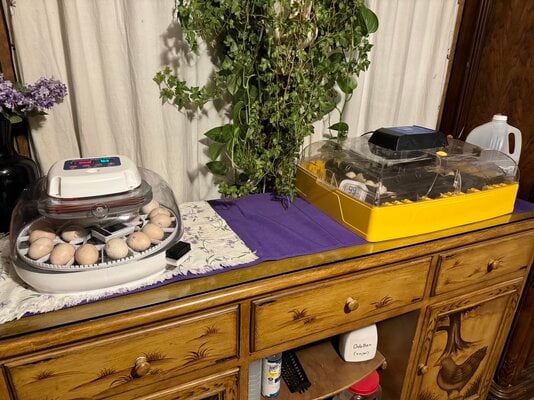What could possibly be more magical for a chicken keeper than watching an egg turn into a tiny life right before our eyes? That's right, hatching your own eggs! We aren't going to discuss the hatching process today but rather the cleaning of the eggs before setting them. Most will tell you not to clean eggs before setting to protect the bloom; however, the following experiment will discuss killing the Mareks virus that could be present on the outside of the eggs, (should these eggs come from an infected flock), to prevent the chicks from contracting Mareks at hatch.
So why sterilize them? If you have any reason to believe, suspect, or know that where you purchased hatching eggs, or your own hatching eggs, may have been exposed to a disease, illness, or virus, such as Marek's Disease, then you'd want to make sure this isn't carried on to the chicks from the eggshells when they hatch.
Marek's disease, among others, is spread by the dust and dander from infected or carrier chickens. It is conceivable that this same dust/dander could make its way onto the eggs of hens or of those purchased elsewhere.
Is it safe to sanitize your eggs?
It depends what you're using but in most cases, yes. Sanitizing of eggs is done by hatcheries, and some breeders do as well; however, none are known to kill Herpes Virus 2 on their eggs.
This article explains further if you wish to read more about general sanitation.
https://extension.msstate.edu/content/sanitation-hatching-eggs#
What products will kill Marek's disease on surfaces, such as coops, incubators, and even eggs?
I have not had Marek's here, but was saddened to hear a BYC friend, @2ndTink, had Marek's hit her flock. I dug into this because hatching eggs coming from a coop that's been infected with Marek's would not be advisable to chance it. I started researching and found that several products kill things like H1N1/ avian flue, etc, but Marek's Disease Virus (MDV) is classified as a Herpes virus 2 (Gallid alphaherpesvirus 2) (GaHV-2). The number of effective products to kill that drops drastically. Someone suggested Oxine, but that kills Herpes virus 1, not 2.
I was specifically looking for products that kill the Herpes 2 virus and did find some disinfectant wipes that would, but I was looking for a less abrasive way to not disturb the bloom. I found an article that stated Odoban is used in hatcheries, hospitals, etc., and that it kills Herpes virus 2. I went to Odoban's site and found out what it kills, how to kill it, and that indeed, Herpes virus 2 is one of them. This chart explains the ratio. For Herpes Virus 2, and all viruses, plus using it for a Bactericidal, it is 5 oz Odoban per gallon for 60 seconds on a clean surface.

To read more about Odoban: https://odoban.com/what-is-odoban/
I could find no information about how to kill Marek's disease on hatching eggs. Even though Odoban is used in hatcheries, it never mentions anything about eggs. Thus, since I had some hatching eggs already being shipped to me, I thought it would be a great time to fire up a second incubator and test some of my own eggs to determine:
The Experiment:
1/06/2024
I selected 10 of my own silkie eggs. I numbered and marked five of them with an O, and the other five were just numbered. (I was doing a hatch-along so thus why the numbering.) The reason the five regular eggs were put in with these Odoban-dipped eggs was to bring normal bacteria eggs may have on them into the incubator with the sanitized eggs.
I made a quart of Odoban solution by mixing 1.25 oz. of Odoban from a gallon jug of it I already had, in a quart bottle and filling it with lukewarm tap water. (Ratio is 5 oz/gallon).

I poured some of this solution into a plastic bowl and soaked the five eggs marked with O's for 60 seconds.


I quickly rinsed them and set them on paper towels to dry.

Once dry, these five were set on one end of a Brinsea 56EX incubator, and the other five were set on the opposite end. These 10 eggs were the only eggs in this incubator. They were set at 7:00 p.m. CST on 1/06/2024, with a due date (21 days) of 1/27/2024.

Seven days later I candled, and removed two of the O (Odoban-dipped) eggs and two of the five regular eggs with them, due to being unfertilized or non-starters.
They were candled again on 1/21/2024. All six remaining eggs were viable. They were locked down on 1/23/2024.
On the morning of 1/26/2024, the first egg to hatch was an Odoban-dipped egg, as was the second one shortly behind it. (20th day.) The third Odoban-dipped egg hatched the morning of 1/27/2024.
Here are the three chicks whose egg was soaked for 60 seconds in Odoban solution.

FINDINGS:
The 60-second sanitization process using Odoban did not affect the hatch rate, nor did the unwashed eggs affect the OdoBan eggs.
Since finishing this experiment, several have already gone ahead and sterilized their hatching eggs with Odoban. If you're one of them, please post your results upon hatching and share with us how it went.
While we all hope never to have the dreaded Mareks turn up in our flocks, it can strike unexpectedly. This experiment only followed the chick up to hatching. Ultimately, time will tell whether or not the OdoBan affected fertility, organs, or any DNA of future offspring. I will update this article as the chicks mature, lay, and reproduce. Thank you for tagging along!
A huge thanks to @TwoCrows and @2ndTink for their insight and assistance in putting this experiment and article together. I also thank all of those who participated in the hatch-along/experiment as you helped make it so fun!
So why sterilize them? If you have any reason to believe, suspect, or know that where you purchased hatching eggs, or your own hatching eggs, may have been exposed to a disease, illness, or virus, such as Marek's Disease, then you'd want to make sure this isn't carried on to the chicks from the eggshells when they hatch.
Marek's disease, among others, is spread by the dust and dander from infected or carrier chickens. It is conceivable that this same dust/dander could make its way onto the eggs of hens or of those purchased elsewhere.
Is it safe to sanitize your eggs?
It depends what you're using but in most cases, yes. Sanitizing of eggs is done by hatcheries, and some breeders do as well; however, none are known to kill Herpes Virus 2 on their eggs.
This article explains further if you wish to read more about general sanitation.
https://extension.msstate.edu/content/sanitation-hatching-eggs#
What products will kill Marek's disease on surfaces, such as coops, incubators, and even eggs?
I have not had Marek's here, but was saddened to hear a BYC friend, @2ndTink, had Marek's hit her flock. I dug into this because hatching eggs coming from a coop that's been infected with Marek's would not be advisable to chance it. I started researching and found that several products kill things like H1N1/ avian flue, etc, but Marek's Disease Virus (MDV) is classified as a Herpes virus 2 (Gallid alphaherpesvirus 2) (GaHV-2). The number of effective products to kill that drops drastically. Someone suggested Oxine, but that kills Herpes virus 1, not 2.
I was specifically looking for products that kill the Herpes 2 virus and did find some disinfectant wipes that would, but I was looking for a less abrasive way to not disturb the bloom. I found an article that stated Odoban is used in hatcheries, hospitals, etc., and that it kills Herpes virus 2. I went to Odoban's site and found out what it kills, how to kill it, and that indeed, Herpes virus 2 is one of them. This chart explains the ratio. For Herpes Virus 2, and all viruses, plus using it for a Bactericidal, it is 5 oz Odoban per gallon for 60 seconds on a clean surface.
To read more about Odoban: https://odoban.com/what-is-odoban/
I could find no information about how to kill Marek's disease on hatching eggs. Even though Odoban is used in hatcheries, it never mentions anything about eggs. Thus, since I had some hatching eggs already being shipped to me, I thought it would be a great time to fire up a second incubator and test some of my own eggs to determine:
- Would soaking an egg for 60 seconds in this solution kill the embryo?
- Would soaking an egg for 60 seconds in this solution ruin the bloom, thus allowing bacteria to access the egg?
The Experiment:
1/06/2024
I selected 10 of my own silkie eggs. I numbered and marked five of them with an O, and the other five were just numbered. (I was doing a hatch-along so thus why the numbering.) The reason the five regular eggs were put in with these Odoban-dipped eggs was to bring normal bacteria eggs may have on them into the incubator with the sanitized eggs.
I made a quart of Odoban solution by mixing 1.25 oz. of Odoban from a gallon jug of it I already had, in a quart bottle and filling it with lukewarm tap water. (Ratio is 5 oz/gallon).
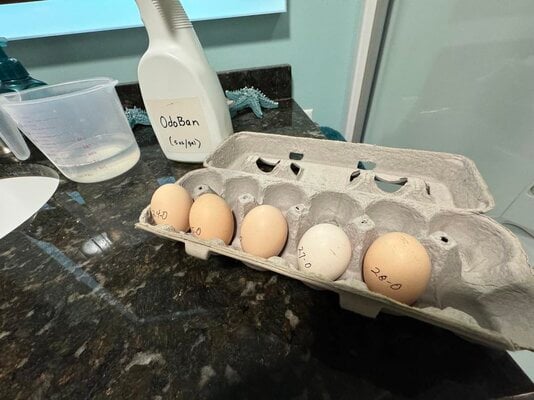
I poured some of this solution into a plastic bowl and soaked the five eggs marked with O's for 60 seconds.
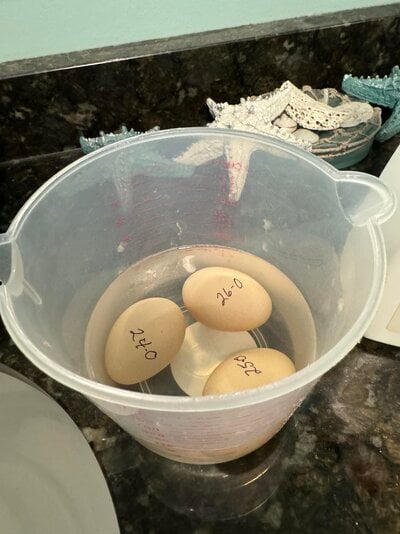
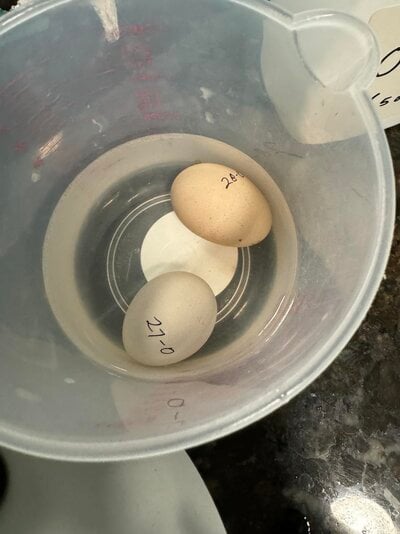
I quickly rinsed them and set them on paper towels to dry.
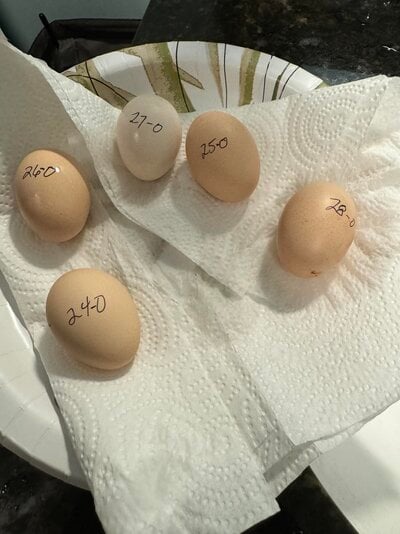
Once dry, these five were set on one end of a Brinsea 56EX incubator, and the other five were set on the opposite end. These 10 eggs were the only eggs in this incubator. They were set at 7:00 p.m. CST on 1/06/2024, with a due date (21 days) of 1/27/2024.
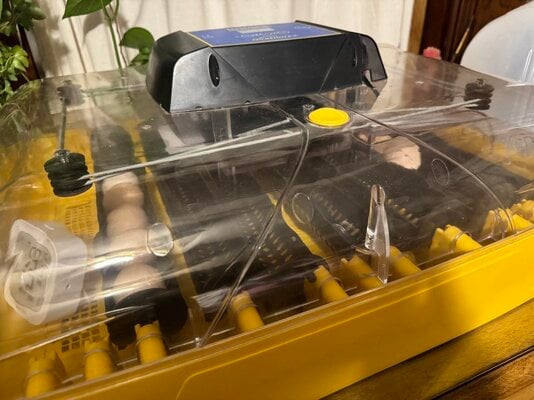
Seven days later I candled, and removed two of the O (Odoban-dipped) eggs and two of the five regular eggs with them, due to being unfertilized or non-starters.
They were candled again on 1/21/2024. All six remaining eggs were viable. They were locked down on 1/23/2024.
On the morning of 1/26/2024, the first egg to hatch was an Odoban-dipped egg, as was the second one shortly behind it. (20th day.) The third Odoban-dipped egg hatched the morning of 1/27/2024.
Here are the three chicks whose egg was soaked for 60 seconds in Odoban solution.
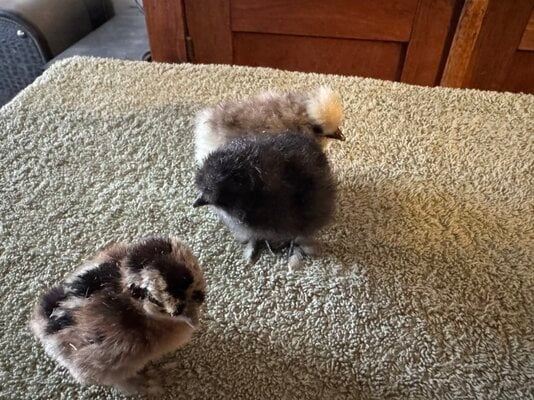
FINDINGS:
The 60-second sanitization process using Odoban did not affect the hatch rate, nor did the unwashed eggs affect the OdoBan eggs.
Since finishing this experiment, several have already gone ahead and sterilized their hatching eggs with Odoban. If you're one of them, please post your results upon hatching and share with us how it went.
While we all hope never to have the dreaded Mareks turn up in our flocks, it can strike unexpectedly. This experiment only followed the chick up to hatching. Ultimately, time will tell whether or not the OdoBan affected fertility, organs, or any DNA of future offspring. I will update this article as the chicks mature, lay, and reproduce. Thank you for tagging along!
A huge thanks to @TwoCrows and @2ndTink for their insight and assistance in putting this experiment and article together. I also thank all of those who participated in the hatch-along/experiment as you helped make it so fun!

